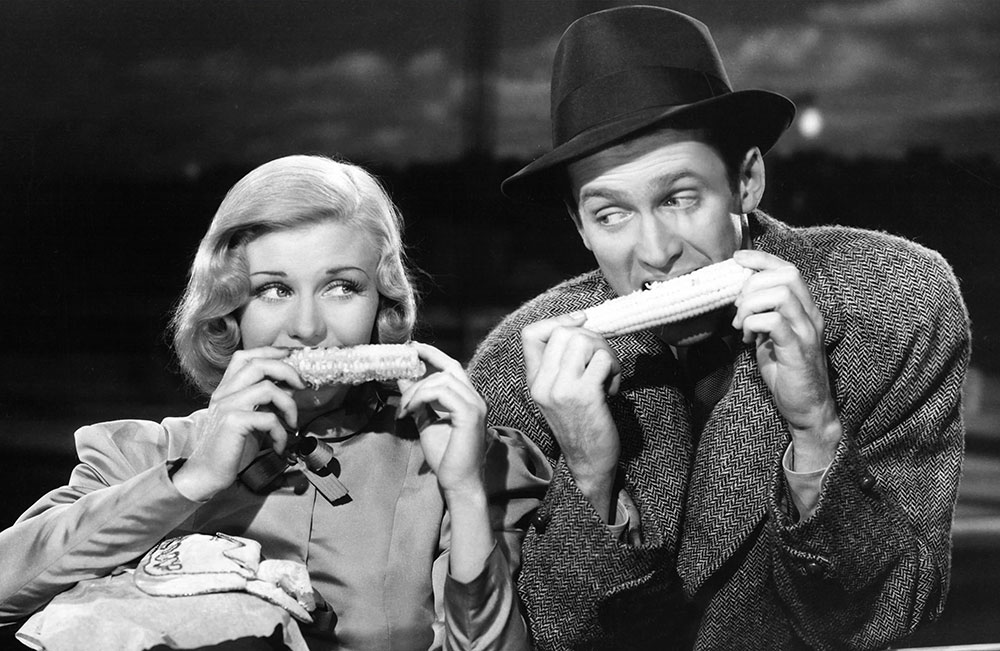When they met for a summit in the spring of 1976, Andy Warhol and Ginger Rogers had much to discuss. Over frozen hot chocolate and frankfurters, they gabbed about the political climate, the implications of smoking black cigarettes, and the status of Warhol’s crusade to secure a government pension for old movie stars. (It hadn’t gotten very far.) Ginger closed the conversation by trashing contemporary Hollywood, praising by counterpoint the exquisite Hays Code indirection of “a film that I was in with Jimmy Stewart," the George Stevens-directed romance Vivacious Lady (1938). “Those are the things, you see, that the industry has lost,” she said, staring despondently into her empty chocolate glass. “It does not do the wonderful turn ideas. It comes right down and…a glass is a glass is a glass is a glass.”
Vivacious Lady could reduce anyone to sulking over the state of modern life. Shot on the RKO lot concurrently with Stage Door (1937) and Bringing Up Baby (1938), the film seems at first like an amiable botch—a screwball comedy with no urbane dialogue, no deliciously convoluted plot mechanisms, and no gold lame—but its shortcomings are by design. The saga of a botany professor (James Stewart) and a nightclub singer (Ginger Rogers) who marry and then spend days fruitlessly searching for a place to fuck, Vivacious Lady is a comedy so horny that it forgets to be witty; instead the characters float around slack-jawed in a haze of unconsummated lust. As Stewart tells Rogers at one point, “You don't have to say anything. You speak for yourself—and very eloquently, too." The movie is full of wonderful bits of business, but they’re mostly physical or gestural, the jokes of teenagers who haven’t slept all night and are getting a little punchy. The most memorable: a scene where Ginger’s studio apartment turns into an erotic organism that must be carefully stroked—its doors slammed, its desk drawers pushed shut—in order for the Murphy bed to pop open.
For George Stevens, the film’s tongue-tied aesthetic could be traced to his leading man. “The movie was really about the pleasant frustration of non-communication,” he observed. “This was very close to Jimmy Stewart’s vein of expression—this struggle to get anything said.” A few years later, while filming The Philadelphia Story (1940), Stewart would agonize over the speech in which Macaulay Connor tells Tracy Lord, “You’ve got fires banked down in you, hearth fires and holocausts.” As Katharine Hepburn put it, “It was not exactly a Jimmy Stewart line.” In Vivacious Lady, he only gets Jimmy Stewart lines: blunt, artless things like “The 4 am train leaves at exactly 4 am and I’m gonna be on it and so are you.” He is a clod, and he’s irresistible.
Ginger Rogers is good, too, even though she sneaks in a bit of baby talk, which she mistakenly saw as one of her strengths. Typecast as a proletariat, she gets to slap around a society girl and weep while consuming a ham sandwich; in one scene she wears a flared dress with pointy shoulder pads that makes her look like one of the Wicked Witch’s henchmen. She and Stewart dated during production, and you can sometimes catch her in the act of sardonic appraisal, as if thinking, “Do I really see myself with someone who has this much trouble taking off a pair of gloves?” The match didn’t work out in life, and it’s a credit to all the “wonderful turn ideas” animating Vivacious Lady that it almost works on film. As George Stevens admitted, “The boy and the girl had no business getting together.”
Vivacious Lady screens this evening, October 13, at Film Forum on 35mm as part of the series “George Stevens.”



